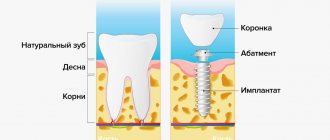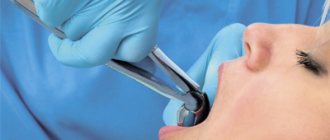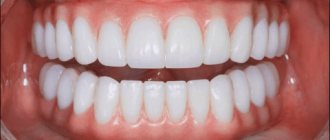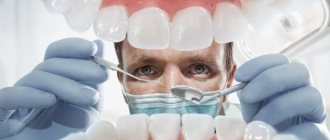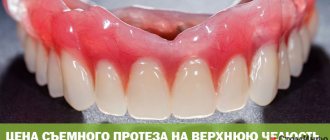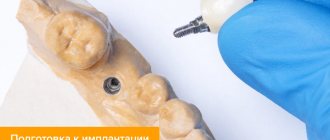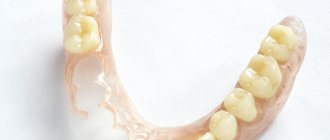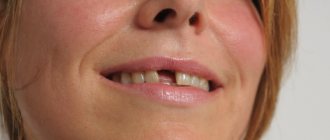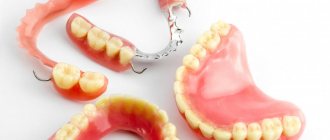The time for dental implantation is determined by several factors:
- Has bone grafting been performed?
- Are there any foci of infection in the oral cavity, and how much work will be required for treatment;
- What method is the surgery planned for?
In addition, the patient will have to undergo tests, have an X-ray and CT scan, and, if necessary, undergo treatment for other non-dental diseases if they are a contraindication for implantation.
Preliminary consultation
This stage is mandatory and is carried out in order to ensure high-quality dentures. A preliminary consultation helps the patient understand the many questions he has and allows him to correctly plan the upcoming prosthetics.
The procedure takes no more than 30-40 minutes. During the initial appointment, the dentist carries out the following actions:
- Oral examination, in which the condition of the mucous membrane, teeth, the quality of oral hygiene, the functionality of the masticatory muscles, the mandibular temporal joint, and the patient’s posture are assessed.
Attention is also paid to the condition of existing fillings and the need to replace them is determined.The installed prosthetic structures (if any) are inspected, the degree of sensitivity of the teeth is checked, signs of dental diseases are identified and the stages of their development are determined, the issue of the need for preliminary treatment is resolved.
- Interview and anamnesis collection . Informing about all types of upcoming work, features of preparation for prosthetics, type of anesthesia, progress of the operation, priority and sequence of all manipulations.
- Selection of the most optimal type of prosthetics , material of the prosthesis, method of its fastening.
- Drawing up a preliminary plan for subsequent actions, taking into account the complexity of the clinical case. Clarification of the price of the work, as well as deadlines.
If necessary (if the clinic is complex), consultations with highly specialized specialists are prescribed - a dental surgeon, orthodontist, therapist, periodontist.
Each of the doctors, taking into account the specifics of their specialty, will indicate the possible presence of hidden problems and recommend the optimal solution to the problem of missing teeth. Joint actions of doctors will allow you to accurately plan treatment, prevent complications and ensure high-quality results.
Indications for installation of a soldered prosthesis and design features.
Come here to take a closer look at composite bridges.
At this address https://www.vash-dentist.ru/protezirovanie/nesemnyie-p/problem-s-zubami-v-heyhe.html we’ll talk about the price of dental prosthetics in Heihe.
Diagnostics
Diagnostics is a mandatory procedure in the therapeutic stage of preparation for prosthetics.
Its purpose is to determine the quality and thickness of the jaw bone, the condition of dental roots and canals, identify pathologies that occur in a latent form, and study the features of the bottom of the maxillary sinus and maxillary sinuses.
The results of diagnostic examinations are needed to determine the indications (limitations) for prosthetics, choose the method of tooth restoration and the type of prosthetic structure.
Thanks to a comprehensive study of the dental system, it is possible to prevent complications and extend the life of the prosthesis.
Today the therapeutic stage practices the following types of research:
- CT scan (CT).
An informative diagnostic method that allows you to obtain an accurate three-dimensional image of the patient’s dentoalveolar apparatus, by which the doctor can identify hidden anomalies, assess the condition of the alveoli, check the quality of the jaw bone, and determine root defects.The image is clear enough and can be viewed in all projections and enlarged (if necessary), which has a positive effect on the accuracy of drawing up a treatment plan.
The average duration of a scan is no more than 10 seconds, plus you need to add time for the doctor to draw up a card, prepare for the procedure, position the device, and print out the result.
Computed tomography is convenient for that category of people who have permanent metal prosthetic structures.
- Orthopantomogram.
This is one of the common types of x-ray examination, otherwise known as a panoramic image (with two-dimensional visualization).The orthopantomogram shows a clear picture of the condition of the entire dentofacial apparatus, i.e. Using the image, you can not only study the condition of all remaining teeth, the temporal joint and the jaw bone (its density and volume), but also determine the distance to the maxillary sinuses, consider their condition and location.
A panoramic image also helps to create a correct and competent treatment plan. The duration of the diagnosis is no more than 15 minutes, the image is taken within 5 minutes.
- MRI (Magnetic resonance imaging).
A diagnostic method used to determine the presence of hidden pathologies of the dental system, determining the quality and condition of tissues.Among the advantages is the ability to obtain a clear 3D image without distortions and errors with increased contrast, which allows you to study in detail the area of the proposed restoration. The average duration of the examination is about half an hour.
- Radiovisiography.
This is an X-ray diagnosis of the condition of the dental system, displaying the result on several or one targeted image.They are used both for the study of a single dental element and its roots, and for diagnosing the condition of the periodontal tissues and jaw bone. The approximate duration of the process is 7-10 seconds.
Important! The doctor decides which diagnostic method will be prescribed, based on the characteristics of the clinical case and the scope of the upcoming treatment.
It is impossible to accurately indicate the duration of the clinical stage - it all depends on the age of the patient, his state of health and the duration of obtaining the result, i.e. from 1 day to 10 days (if you wait for the result for HIV infection).
Basal complex
Basal dental implantation is a comprehensive method of restoring the dentition in case of acute atrophy of the jaw bone. This protocol provides for the implantation of artificial roots not into spongy bone, which is subject to the process of decline, but into the deeper layers of bone tissue, not only the jawbone, but also the zygomatic bone, as well as the buttresses of the skull, which are not subject to resorption processes. The basal complex is an ideal option if you need to quickly restore the normal functionality of the dentofacial apparatus with partial (absence of more than 3 teeth in a row in a row) or complete edentia.
One-stage implantation protocols, which include the basal complex, allow you to do without additional operations to build bone tissue and other surgical procedures. The ability to place implants immediately after tooth extraction and immediately load them with a prosthesis allows you to reduce treatment time to just a few days. To restore one row of teeth, from 8 to 12-14 implants are needed. The cost of the complex does not depend on the number of implants installed.
The basal protocol provides for the following stages of dental implantation:
- Preparatory
– an examination of the oral cavity is carried out, an anamnesis is collected about the general state of health. This is followed by a more in-depth diagnosis - X-ray assessment of the qualitative and quantitative parameters of the jaw bone (orthopantomogram, 3D tomography), a series of blood tests, consultations with specialists (if indicated). All existing dental problems are eliminated: hard and soft deposits are removed, teeth and gums are treated.
The doctor, using special software, selects the optimal implantation system, calculates the most optimal installation sites in terms of quantity and quality of bone tissue and the angle of inclination of the implants, predicts the course of the operation and prepares an individual surgical template, which allows artificial dental roots to be implanted into the allocated areas with precision and without the risk of displacement places.
- Installation of implants and abutments
- in the presence of non-viable teeth and roots, their removal is carried out along with the implantation procedure. Artificial roots are implanted using a minimally invasive method, without incision in the gums - translingually (through a mini-puncture in the gums) or into the socket of a just extracted tooth. After installing the implants, the doctor takes impressions from which the prosthesis will be made and conducts control X-ray diagnostics to ensure the correct installation of the implantation system. - Installation of a denture
– 1-2 days after implantation, fitting, correction (if necessary) and installation of an orthopedic structure made according to an individual impression on the abutments is carried out. The installed prosthesis is fully functional and can be immediately used for its intended purpose (with a gradual increase in chewing loads).
Postoperative recovery with the basal protocol takes no more than 2-3 days, and complete rehabilitation takes up to 7 days. The entire procedure will require no more than 3-4 visits to the doctor. The minimum time to wear an adaptive prosthesis is 6-12 months, the maximum is 5 years. After this, the orthopedic system must be replaced with a permanent structure made of metal ceramics or zirconium.
Handling Problem Units
Dental prosthetics involves mandatory processing (preparation) and depulpation.
Grinding is the grinding down of hard dental tissues to achieve a smooth and perfectly even surface. After all, it is precisely this surface that is an important condition for ensuring high-quality fastening of most types of prostheses.
In addition, the teeth are given a shape that exactly replicates the internal cavity of the prosthetic structure, which allows it to be more tightly and accurately secured.
Today, thanks to effective anesthetics and new equipment, preparation is faster (10 minutes is enough for one dental unit) and painless than several years ago.
In practice, teeth grinding can be carried out using one of the following methods:
- Tunneling is a classic technique using a drill with a metal or diamond tip, thanks to which the doctor can grind off any amount of tissue.
- Ultrasonic .
It involves the use of a special apparatus that is capable of transmitting high-frequency vibrations. The tip of the device does not come into contact with the enamel coating, which reduces the risk of accidental damage to the nerve and dentin. Ultrasonic grinding can only remove a small amount of tissue. - Laser . This technique is non-contact and allows you to get the desired result in the shortest possible time. Use is only possible for preparing thin tissues.
- Air-abrasive . The impact on dental tissue occurs using a mixture of water and abrasive particles. The technique is preferable because it eliminates the formation of chips and cracks, and also helps preserve healthy tissue.
- Chemical _
Here the specialist resorts to the help of acids, which are guaranteed to quickly destroy hard tissue. At the end of the process, the softened tissues are removed, and the tooth is given the desired parameters. Chemical preparation is a lengthy procedure (it takes at least 15 minutes to process one element), which is why it is used extremely rarely.
In isolated cases (approximately 10%), tooth depulpation is also performed before prosthetics - this is when inflamed pulp tissue is removed from its root canals.
The procedure takes about 7-10 minutes, is performed under local anesthesia, and only for medical reasons:
- partial exposure of the nerve;
- anatomically incorrect position of the prosthetic element;
- high degree of smoothness of the chewing surface or coronal part;
- mechanical injury, in which there is a high probability of nerve death.
The decision to depulpate the unit being restored is also influenced by the condition of the gums and jawbone, the angle of inclination of the tooth and its position in the row, the volume of the pulp chamber and the type of prosthesis being installed.
Typically, the procedure is carried out before installing metal-ceramic and zirconium crowns, since with this type of prosthetics the pulp becomes more vulnerable due to the removal of a thick layer of hard tissue (2-2.5 mm).
Taking an impression
To achieve a comfortable and tight fit of the prosthesis, as well as ensure proper closure of the jaw arches, the prosthetic design must precisely correspond to the topographic and anatomical specificity of the patient’s oral cavity. For this purpose, an impression is taken from teeth already prepared for prosthetics.
An impression (otherwise known as a cast) in dentistry is the reproduction of the contours of soft tissues, ground and healthy teeth, alveolar cords, palatal transverse suture, and frenulum on impression material.
Important! Without a cast, it is impossible to correctly make a plaster model and make a structure that is optimal in all respects.
Taking into account the clinic and the type of prosthesis chosen, the following groups of materials can be used for the impression:
- elastic;
- hard;
- polyester;
- thermoplastic;
- modeling.
To take an impression, the doctor fills an impression tray with material, inserts it into the patient’s mouth, and places it on the teeth so that they are completely covered in the impression material.
The hardening of the material lasts about 20-25 minutes, after which the spoon is carefully removed, the impression is taken, washed with running water, disinfected and transferred to the laboratory.
Examples of work “Before” and “After”
Basal implantology with immediate loading
Case: The patient complained of an uncomfortable removable denture.
Simultaneous implantation in the lateral sections of the upper and lower jaw
Case: tooth decay under crowns in the lateral sections of the upper and lower jaws.
Restoration of all teeth in 4 days - basal implantation
Case: Absence of all healthy teeth on both jaws.
Single-stage removal and basal implantation (September 2012)
Case: destruction of the chewing group of teeth in the lower jaw.
Manufacturing of the structure
This is the most time-indefinite stage - on average, the production of a prosthesis takes from 7-10 days to 4 weeks.
The duration of production of a prosthetic structure is individual and depends on many facts:
- technical equipment and productive capacity of the laboratory;
- the degree of its workload;
- the material chosen to create the prosthesis;
- type of fastening;
- localization and extent of the restored area;
- type of prosthetic product;
- anatomical features of the mouth.
The approximate production time for some types of prostheses is:
- single – from 7 days;
- bridge - from 12 days;
- partial or complete withdrawal – from 10 days;
- clasp with clasps – from 14 days;
- similar product with a locking fastening – 3 weeks;
- removable plate with implant support – 4 weeks.
These production times are calculated from the day the impression is received until the final fixation of the prosthetic structure in the patient’s mouth by the orthopedic dentist.
Some laboratories may work on a “rush order” system and offer clients, for an additional payment, to produce their prosthesis much earlier than the deadline specified in the contract.
Let's figure out together whether there can be an allergy to crowns and which material is the most dangerous.
In this publication we will look at the stages of making half-crowns.
Here https://www.vash-dentist.ru/protezirovanie/nesemnyie-p/udachnogo-pri-parodontoze.html we will discuss whether prosthetics are possible for periodontal disease.
Creation and installation of various prostheses: what are the stages and how long will it take?
Article navigation
- Stages of prosthetics
- - reorganization
- — photometry
- - casts
- - choice of prosthesis model
- — design and planning
- — creation of a prosthesis
- - first fitting
- — fixation of the structure
- - education
- How long does it take for production?
- Manufacturing time for fixed dentures
- Production time for removable devices
- Care
- QUESTIONS
Question for a specialist
Modern dental prosthetics are affordable and multivariate solutions for restoring the aesthetics of a smile and the function of chewing. In preparation for restoration, the patient goes through several preparatory stages, which include choosing a doctor and clinic, selecting a prosthetic technique and preliminary treatment - they can take from a couple of days to several months. Detailed materials about this can be found on our website. The creation and installation of structures also consist of various procedures. What stages are involved in direct dental prosthetics, and in what time frames the structures are made, we will describe in detail in this article.
Fitting and correction
The finished prosthetic structure requires mandatory fitting before installation. The use of high-precision equipment in the process of its creation will not provide a 100% guarantee that the orthopedic product is absolutely identical to the characteristics of the client’s dentofacial apparatus.
Fitting lasts about 20 minutes. During this procedure, the doctor marks areas that require additional grinding or reducing the surface thickness.
Based on the amount of work required to fit the structure, it may take from 2 to 4 hours to adjust its parameters.
Important! Above is the time for fitting and finalizing one prosthesis. When there are several of them (for example, they are single), or it is a large bridge, the fitting and adjustment period increases accordingly.
Fixation process
For the final installation of the orthopedic structure, the patient needs to spend 40-60 minutes in the dental chair. At that time:
- the prepared dental element is treated with an antiseptic;
- the oral cavity is dried out;
- a composition that increases adhesion is applied to the abutment tooth;
- The crown is placed on dental cement.
After this, you will have to spend another 30-40 minutes with an orthopedic dentist so that the specialist can assess the quality of pronunciation, degree of comfort and other categories indicating the correct installation of the prosthesis or the need for another adjustment, but on the installed structure.
Important! The correction can still be performed several times, i.e. until the desired result is achieved, which prolongs the period of prosthetics.
In the video, the specialist explains what needs to be done first for dental prosthetics.
How long does dental implantation take?
The duration of dental implantation from consultation to installation of the prosthesis, if the classic protocol is used, is three months for the restoration of teeth in the lower jaw, and two months for the upper jaw. This is ideal if the oral cavity is in perfect condition, and healing proceeds quickly and without complications.
The installation of dental implants has absolute contraindications - tuberculosis, cancer, diabetes. There is also a list of relative contraindications, overcoming which makes implantation longer and more expensive. The most common problem is lack of proper dental hygiene. For smoking patients, a bad habit causes a decrease in the effectiveness of implantation:
- Healing is difficult;
- Tartar forms;
- The body is constantly intoxicated.
After tooth extraction, bone atrophy begins. The longer a person lives without a tooth, the higher the likelihood of the need to build up the missing amount of bone tissue.
Advantages of using innovative technologies
Dentistry has been actively developing and undergoing significant changes in recent years. Innovative technologies have become available to patients, making the process of dental restoration safer, faster, more reliable, more comfortable and of higher quality.
Such technologies include:
- CAD/CAM system. This is an abbreviated name for modern computer technology: where CAD - Computer-Aided Design - means design using computer programs, CAM - Computer-Aided Manufacture - production using computer technology.
The system makes it possible to automate all stages of the manufacturing process of an orthopedic structure. - Three-dimensional prosthetics (3D). It involves the inclusion of high-precision computer technologies in all stages of prosthetics, starting from diagnosing the condition of the dental system, ending with the development and creation of a prosthesis.
- CEREC system. This is a computer technology, the peculiarity of which is the production of a prosthetic structure directly in front of the patient’s eyes, i.e. in one visit to the clinic.
- Nobel Procera . Computer technology makes it possible to produce biocompatible, high-precision, ideal in functionality and aesthetics, durable prostheses.
The demand for new technologies in dental prosthetics is constantly growing. Their popularity is explained by a number of significant advantages:
- The patient's time is saved, i.e. The duration of the entire recovery process and the number of planned visits to the doctor are reduced.
- Cash costs are reduced due to the absence of payment for performing bone grafting in case of insufficient jaw bone volume and a reduction in clinic visits.
- The rehabilitation period is shortened and easier.
- There are no risks of complications associated with inaccurate fit, unnecessary trauma, damage to nerves and the maxillary sinus.
- The end result can be visualized, i.e. The patient can view the progress of prosthetics on the computer and see the result.
- Based on the complexity of the case, you can select the optimal prosthesis model or accurately determine the safe place for inserting the implant.
- Tissue trauma is minimal.
- Automation of the manufacturing process of prosthetic structures helps make them accurate and comfortable.
- The human factor is excluded.
Duration of dental prosthetics
Depending on the chosen implantation protocol, the period from implant installation to prosthesis installation may take:
- With the one-stage method - one week, if there is enough bone tissue, gums and teeth are in good condition;
- With the classic two-stage method - approximately six months, such periods are the safest for the patient, since the risk of implant rejection is minimal;
- With the two-stage method, if the patient has problem teeth and bone grafting surgery is necessary, the time period increases by several more months.
There are protocols with immediate loading, when temporary prostheses are installed immediately after surgery or within three days after it. Since prosthetics are performed before osseointegration, the risks of developing inflammatory processes and implant rejection increase.
Implantation takes time and patience. With a responsible attitude towards health in general and the oral cavity in particular, a good result will justify the efforts at each stage.
Reviews
The specific timing of prosthetics primarily depends on the type of structure being installed, the amount of work, the dental restoration technique used and the number of stages.
The exact duration is announced by the doctor after receiving the results of an examination of the patient’s dental system.
You can tell us about your experience of undergoing prosthetics and give recommendations on ways to possibly reduce the duration of this process by leaving a comment on this article.
If you find an error, please select a piece of text and press Ctrl+Enter.
Tags fixed dentures prosthetics
Did you like the article? stay tuned
Previous article
What is the danger of blood oozing from under the crown of a tooth?
Next article
Types of support-retaining clasps in prosthetics
Two-stage implantation with delayed loading
Classic dental implantation is a time-tested and most popular protocol for restoring lost teeth. Among the features of the technique, it is necessary to separately highlight the increased requirements for the quality and quantity of the jaw bone, which is why it is often necessary to use operations to build it up - sinus lift on the upper jaw and osteoplasty on the mandibular segments. This technology makes the most sense for single restorations, especially in the anterior region, where the aesthetics of the gingival contour is of utmost importance.
